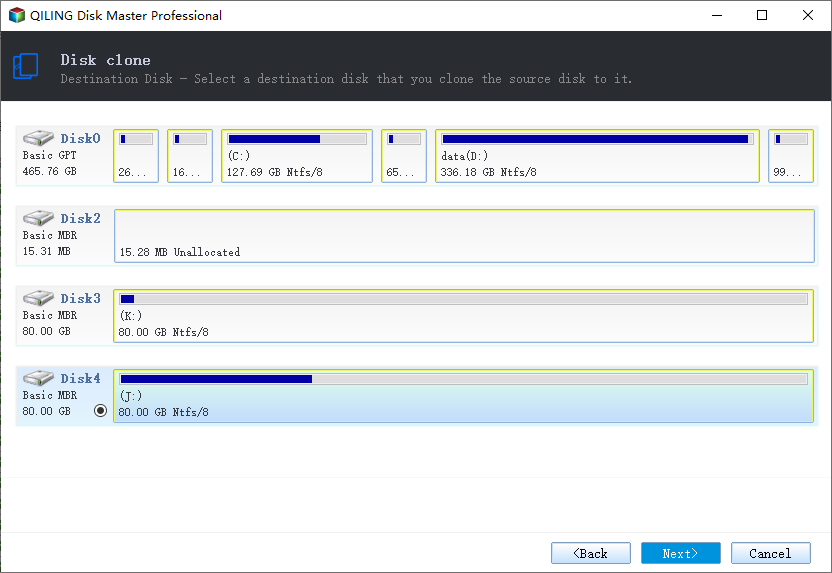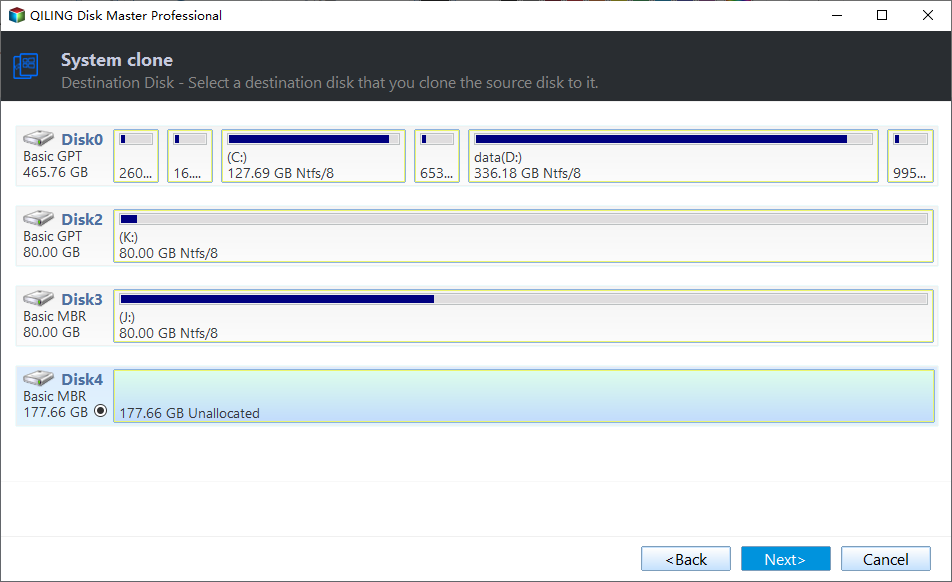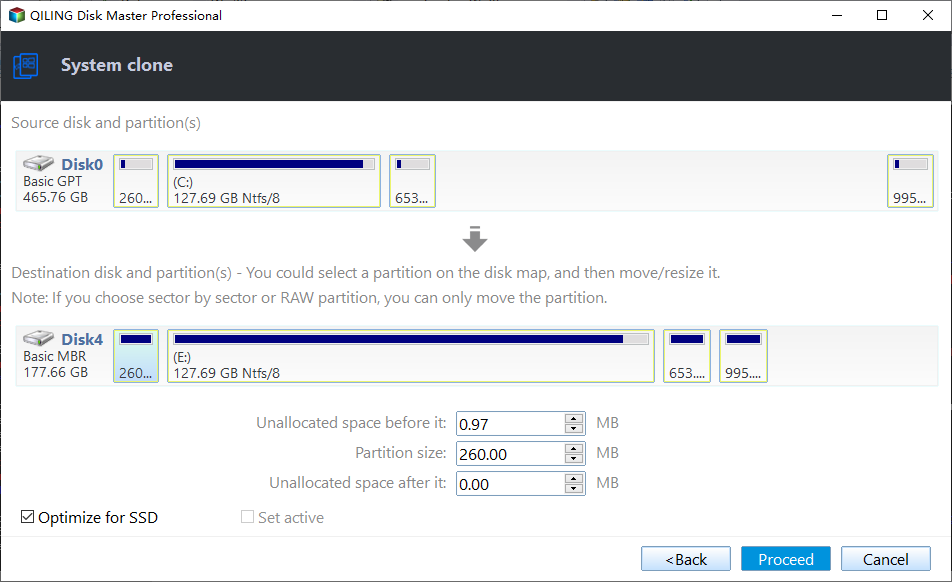Disk Clone vs System Clone - All You Want to Know
What is disk clone or system clone?
In computing, clone is a method of replicating every bit of information from one place to another and making the source and the destination exactly the same. There are two types of clone when it comes to upgrading hard drive: disk clone and system clone. What are they?
- Disk clone is the process of copying the entire disk. All data saved on the drive will be transferred, including the operating system, applications, drivers and personal files.
- System clone copies only the system partition and system-related partition(s), such as EFI system partition and recovery partition. All information that is necessary for system to run in the destination location will be transferred, and so will other files you store on system partitions.
Now you see the difference between disk clone and system clone is to clone either the entire disk or particular partitions. Then, how to choose between them?
System clone vs disk clone: how to choose between them
To choose from disk clone and system clone, you may take following things into consideration:
1. The contents you want to transfer
If you want to get an exact copy of the original drive, then choose disk clone. If you only want to use the old operating system on the new drive, then pick system clone.
2. The capacity of the destination disk
When cloning a larger disk to a smaller disk, you should make sure that the destination disk is big enough to hold all data saved on the source disk if you use disk clone. Sometimes you have to use system clone due to the capacity limitation.
System clone or disk clone? That depends on your demands and how many data your destination disk can hold. As there’s no built-in cloning utility in Windows, you may look for reliable third-party cloning software.
All-in-one cloning software in Windows - Qiling Disk Master
Qiling Disk Master Professional, powerful cloning software for Windows 11/10/8.1/8/7/Vista/XP, offers both Disk Clone and System Clone features. Wanna know Qiling Disk Master Disk Clone vs. System Clone? Please read on.
★ With the Disk Clone feature, you can clone large drive to smaller drive, clone MBR disk to GPT disk, and vice versa. It also enables you to clone HDD to SSD of different brands, such as Samsung SSD, WD SSD, and Crucial SSD. Moreover, you can optimize the performance of the SSD using the SSD Alignment feature.
★ With the System Clone feature, you can transfer OS from SSD to new SSD or from HDD to SSD without effort. The program will select the system partition and system-related partition(s) automatically, which helps to reduce human errors. After cloning, you can enjoy secure boot from the new drive.
Don't hesitate to download and install Qiling Disk Master on your PC.
How to perform system clone or disk clone
Now let’s learn detailed steps of performing disk clone and system clone via Qiling Disk Master. Take cloning to an SSD as an example.
Preparations:
◈ Connect the target SSD to your computer and make sure it is detected.
◈ Backup files on the destination SSD, because the target drive will be overwritten during the cloning process.
Video tutorial:
Graphic tutorial:
Case 1: Clone HDD to SSD via Qiling Disk Clone
Step 1. Run Qiling Disk Master. Click “Clone” on the left pane and select “Disk Clone”.
Step 2. Select the current disk as the source disk.
Step 3. Select the SSD as the destination disk.
Step 4. Tick “SSD Alignment”. Confirm the operation and click “Proceed”.
- Notes:✎...
- Sector by sector clone: it will clone every sector on the source disk no matter it is used or not, which requires the destination disk to be equal to or larger than the source disk.
- To get the best performance from the cloned disk, it's suggested to clone Windows 10 to NVMe SSD. Because it has the fastest transfer speed.
- Besides HDD to SSD cloning software, it is still an M.2 SSD cloner. Thus, you can use it to clone M.2 SSD to M.2 SSD, migrate Windows 10 to M.2 SSD, etc.
Case 2: Migrate OS to SSD using Qiling System Clone
Step 1. Launch Qiling Disk Master. Click “Clone” and select “System Clone”.
Step 2. The required system partition(s) is (are) selected by default. Select the partition on the connected SSD as the destination path and click “Next”.
Step 3. Tick “SSD Alignment” to improve the read/write speed of the target SSD and click “Proceed”.
- Notes:✎...
- Make full use of disk space: If the target disk is larger than the source disk, then the software will by default check Make full use of disk space checkbox to expand the system partition.
- To boot from the new drive, you can either change boot order in BIOS or replace the source disk with the destination SSD.
To sum up
You have learned disk clone vs. system clone from this page. The best cloning software Qiling Disk Master can help you complete these two tasks perfectly. Apart from the clone feature, Qiling Disk Master is specialized backup and sync software. You may use it to do system backup, disk backup, file synchronization and more. If you are a server user who is running Windows Server 2019/2016/2012, etc, Qiling Disk Master Server is available. Go for it right now!
Related Articles
- How to Clone Hard Drive to SSD in Windows 7/8/10? (Updated)
- How to Clone Only OS Partition to SSD in Windows 10/8/7
- How to Do System Clone in Windows 10 without Reinstalling OS
- How to Fix Windows Backup Error Code 0x8078002a [5 Methods]🔥
Nowadays, people tend to consult Windows backup to create a system image or to back up their important files in case of data loss. However, you may encounter an error code 0x8078002a in the process. If you are struggling with that, don't worry. This guide will walk you through all workable solutions to this issue.







